





BMF52.jpg (taken 2.6.2006)

Click to enlarge
BMF53.jpg (taken 2.6.2006)
placename:- King Arthur's Round Table
item:- Arthurian legend
placename:- Arthur's Table
 goto source
goto sourcepage 168:- "...
And neere to this [Karl Lofts] againe, there is a piece of ground,
A little rising Bank, which of the Table round,
Men in remembrance keepe, and Arthurs Table name."
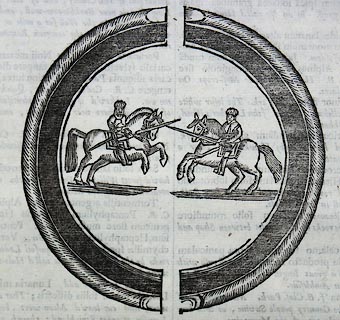 click to enlarge
click to enlargeCAM3E2.jpg
"A little before Loder joyns the Emot, it passes by a large round entrenchment, with a plain piece of ground in the middle, and a passage into it either side; the form whereof is this: ... It goes by the name of King Arthur's Round Table: and 'tis possible enough that it might bea Justing-place; for which reason we have represented the two Warriors on horse-back in the middle. ..."
item:- Armitt Library : A6588.6
Image © see bottom of page
placename:- King Arthur round Table
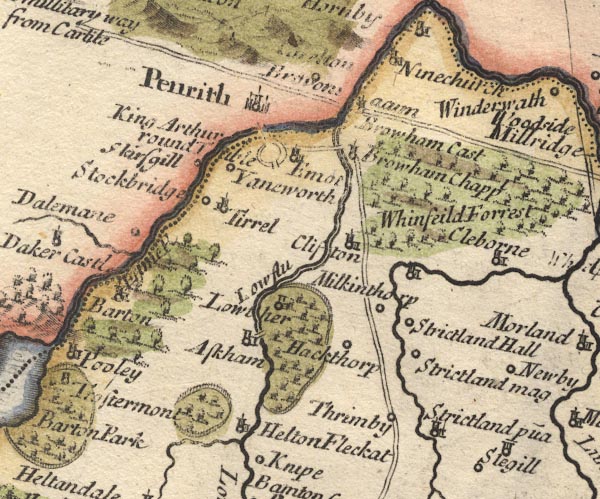
MD10NY52.jpg
"King Arthur round Table"
Double circle with entrances into the earthwork.
item:- JandMN : 24
Image © see bottom of page
"So I returned [from Lowther Hall] 4 mile back to Peroth ... and came by a round green spott of a large circumfference which they keep cut round with a banke round it like a bench; its story is that it was the table a great Giant 6 yards tall used to dine at and there entertained another of nine yards tall which he afterwards killed; there is the length in the Church yard how farre he could leape a great many yards; ..."
placename:- King Arthur's Round Table
item:- cockpit; wrestling; jousting; tournament
 goto source
goto sourcePage 1025:- "..."
"That which the Country People call King Arthur's Round Table is a little to the South of the Conflux of the Lowther and Eimot. There's a Trench on the Inside of it, by which some think it was a Place for Justs and Tournaments; but others that it was only a Cockpit, or a Ring to wrestle in. ..."
placename:- King Arthur's Table
 goto source
goto source"... at a little Distance from the Conflux of the Eimont and Lodor, (at"
 goto source
goto source"which is the round Trench, called King Arthur's Table) ..."
placename:- King Arthurs Round Table

BO18NY42.jpg
"K. Arthurs Round Table."
double circle
item:- Armitt Library : 2008.14.10
Image © see bottom of page
placename:- King Arthurs Round Table
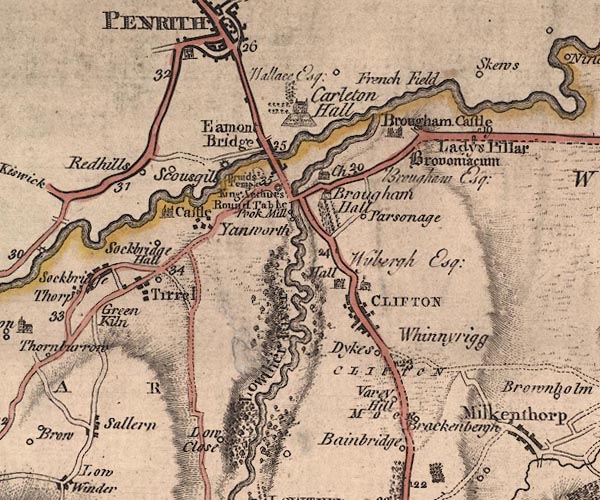
J5NY52NW.jpg
"King Arthurs Round Table"
double circle
item:- National Library of Scotland : EME.s.47
Image © National Library of Scotland
placename:- King Arthurs Round Table
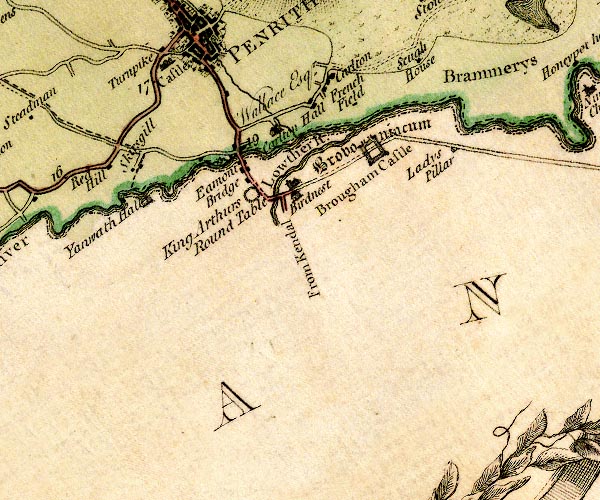
D4NY52NW.jpg
"King Arthurs Round Table"
circle of hachures or dots
item:- Carlisle Library : Map 2
Image © Carlisle Library
 goto source
goto sourcePage 171:- "... Near Eamont bridge is Arthur's round table, and at a small distance from it is Mayburgh, both of remote antiquity, and doubtful use. The first may be presumed to have been a place of public exhibition for martial exercises, ..."
placename:- King Arthurs Round Table
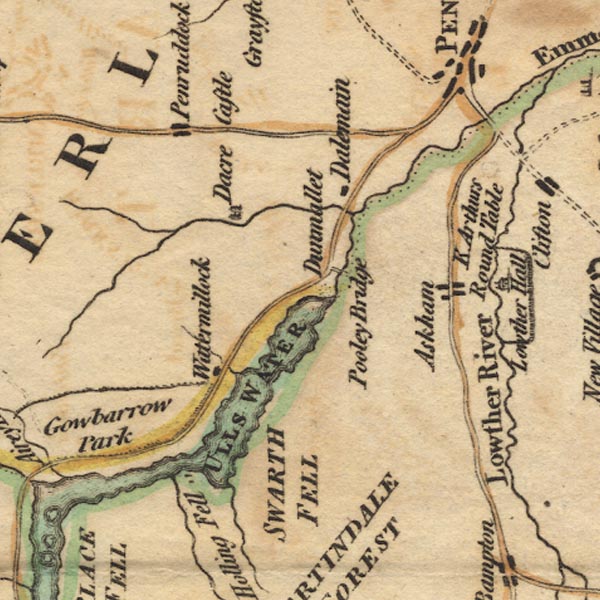
Ws02NY42.jpg
item:- Armitt Library : A1221.1
Image © see bottom of page
placename:- Arthur's Round Table
placename:- Round Table
item:- Arthurian legend
 goto source
goto sourcePage 8:- "..."
"About three hundred yards from Lowther Bridge, by the road-side, is a monument of antiquity, called by some Arthur's Round Table, by others simply the Round Table. Authors differ widely as to the origin and use of this place; but there cannot, I think, be a doubt, that it hath been a place for the exercise of arms. It is round, about an hundred and twenty feet diameter, surrounded by a broad ditch, (two openings excepted, which are diametrically opposite to each other,) and all round is a sloping bank of earth, seemingly intended for the accommodation of spectators."
"If we allow this to have been a place for the exercise of chivalry, the name of Arthur's Round Table may not improbably be esteemed the genuine one. King Arthur is said to have lived much at Carlisle, and most of the old songs and poems concerning him and his knights have their scene laid in this country, and with these the popular traditions accurately agree, as we shall see hereafter: it is farther remarkable, that the old songs were lost in English, but were afterwards translated from the French, in which language they had been preserved almost entire."
"The History of the Order of the Round Table is briefly this: King Arthur observing many quarrels about precedency among his knights, about the year 516 caused a Round Table to be made, at which all the Order, the Sovereign himself not excepted, took their seats promiscuously: To this Table none were admitted but those who had given sufficient proof of their valour and dexterity in the use of arms. As there are some who even deny the existence of King Arthur, I shall not insist farther on this subject, but refer them to other authors, whose province it is more particularly to inquire into these affairs: I shall, however, add from Favine, (lib.5. p.97.) a list of the first table of these knights."
"ARTHUR, King of Great Britain."
"Galaad. / Percival. / Lancelot. / Gawaine. / Boors. / Lyonnel. / Helias le Blanc. / King Baudomages. / King Ydiir. / King Rions. / King Karadoc of Wales. / The King of Clare. / The Duke of Clarence. / Hector de Marests. / Blioberis. / Gueriot. / Keux de Seneschal. / Yrien the Son of King Vrian. / Brunor the Black. / Bedonier the Constable. / Agloual. / Securades, and / Patrides."
"Caxton's old book exhibits a greater number, with the distinguishing epithet of each; but this seems to come nearest the truth, or rather the ancient story."
"..."
placename:- Round Table, The
placename:- Arthur's Castel
item:- Little Round Table
 goto source
goto sourcePage 161:- "..."
""Within a mile of Perith, but in Westmoreland, is a ruin, as some suppose of a castle, within a flite shot of Loder, and as much of Emot water, standing almost as a mediamnis between them. The ruine is of some called the Round table, and of some Arthur's castel. ...""
"..."
 goto source
goto sourcePage 162:- "... a large circular earthwork, single trenched, the ditch within 29 yards diameter, the two entrances opposite to each other north-west and south-east. This is called Arthur's Round Table. A small distance from this to the south is another such earthwork, consisting only of a low rampart, and called the Little Round Table."
placename:- King Arthurs Round Table
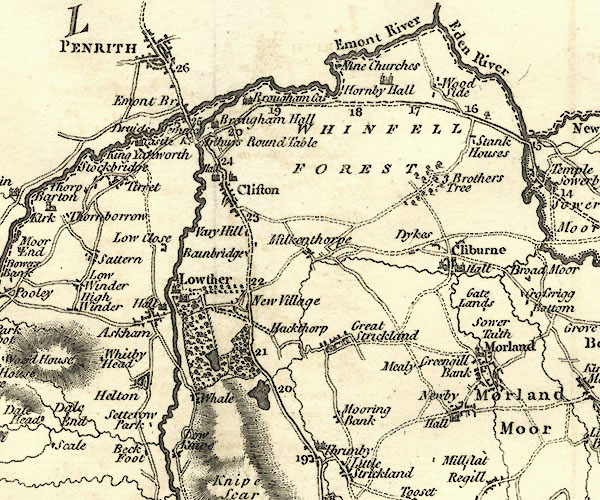
CY24NY52.jpg
"K. Arthurs Round Table"
circle
item:- JandMN : 129
Image © see bottom of page
placename:- Arthur's Round Table
pp.25-26:- "... A circular entrenchment seen near the road is called Arthur's round table, supposed by some to have been a place for tournaments in the Saxon times, and by others to have been erected in commemoration of a peace concluded here between the kings of England Scotland and Wales. ..."
placename:- King Arthur's Round Table
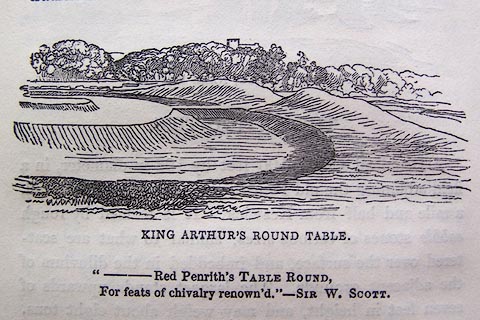 click to enlarge
click to enlargeO80E20.jpg
item:- Armitt Library : A1180.21
Image © see bottom of page
placename:- King Arthur's Round Table
 goto source
goto sourcePage 82:- "King Arthur's Round Table is a circular plot of ground about forty yards in diameter, encompassed by a trench and bank of earth; with places of entrance on two opposite sides. It is situated between the rivers Eamont and Lowther, rather more than a mile from Penrith, on the road to Kendal."
".. The dates and purposes of these two interesting pieces of antiquity [Mayburgh], are left entirely to conjecture."
 goto source
goto sourceGentleman's Magazine 1825 part 1 p.515 "Compendium of County History. - Westmorland."
"At the South end of the village of EAMONT is a curious circle, consisting of a high dyke of earth and a deep foss within, commonly called Arthur's Round Table. Various are the conjectures respecting it."
placename:- Arthur's Round Table
 goto source
goto sourcePage 133:- "..."
"... Arthur's Round Table, on the banks of the stream, an amphitheatre twenty-nine yards in diameter, surrounded by a ditch and mound. ... Antiquarians have hazarded several but unsatisfactory conjectures, as to the uses of these mysterious structures. They are evidently of British origin, ..."
placename:- Arthur's Round Table
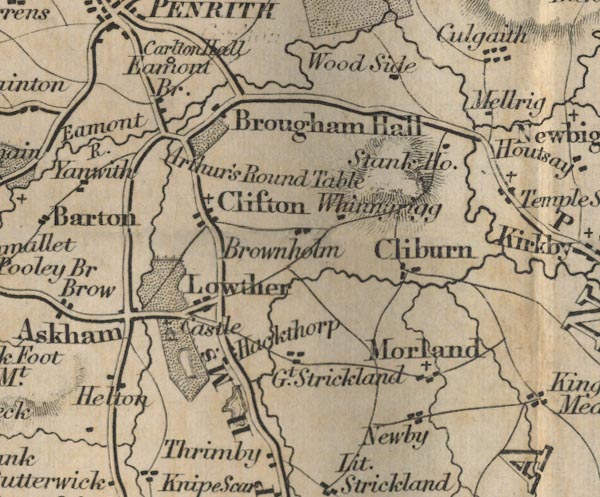
FD02NY52.jpg
"Arthur's Round Table"
item:- JandMN : 100.1
Image © see bottom of page
placename:- King Arthur's Round Table
HP01p126.txt
Page 126:- "..."
"... the Lowther is crossed at Lowther Bridge. Beside the river and immediately skirting the road, is the earthwork known as "King Arthur's Round Table," an ancient raised platform whose purpose can only be guessed at. Not King Arthur, but the Norse settlers, are held to have been the originators of it, as the stage whereon their rude displays of arms were held: in particular a duel known as "holmegang," a species of gladiatorial combat in which the opponents were armed with knives, bound together, and then compelled to fight to the death. Such are the fearful memories of this now peaceful scene. ..."
placename:- King Arthur's Round Table
 click to enlarge
click to enlargeHMW147.jpg
On p.252 of the Inventory of the Historical Monuments in Westmorland.
printed, top "KING ARTHUR'S ROUND TABLE / In Yanwath parish"
RCHME no. Wmd, Yanwath and Eamont Bridge 12
item:- Armitt Library : A745.148
Image © see bottom of page
